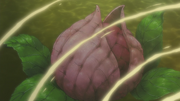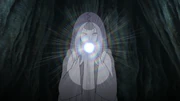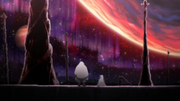Omnibender (talk | contribs) (I think this image should be in this article, but I have no idea where it would fit best) Tag: sourceedit |
Kunoichi101 (talk | contribs) m (→Trivia) Tag: sourceedit |
||
| Line 18: | Line 18: | ||
== Trivia == |
== Trivia == |
||
| − | [[File:God Trees.png|thumb| |
+ | [[File:God Trees.png|thumb|right|Momoshiki and Kinshiki oversee multiple God Trees.]] |
* The God Tree is similar to both the [[Wikipedia:World tree|world tree]] and the [[Wikipedia:Tree of life|tree of life]], motifs that are present in several real-life religions and mythologies throughout the world. In addition, it shares similarities to [[Wikipedia:Jubokko|Jubokko]], a [[Wikipedia:Yōkai|yōkai]] tree that appears on former battlefields and feeds on the blood of humans. |
* The God Tree is similar to both the [[Wikipedia:World tree|world tree]] and the [[Wikipedia:Tree of life|tree of life]], motifs that are present in several real-life religions and mythologies throughout the world. In addition, it shares similarities to [[Wikipedia:Jubokko|Jubokko]], a [[Wikipedia:Yōkai|yōkai]] tree that appears on former battlefields and feeds on the blood of humans. |
||
** The God Tree bearing the fruit that was deemed forbidden to consume is very similar to the story of the [[Wikipedia:Tree of the knowledge of good and evil|Tree of the knowledge of good and evil]] in [[Wikipedia:Abrahamic religions|Abrahamic religions]], in which [[Wikipedia:Adam and Eve|Adam and Eve]], the first humans, ate the forbidden fruit despite being told otherwise. Ultimately, while becoming wiser, it lead to their downfall by incurring the wrath of God. For disobeying Him, He forever cursed the two and their descendants. Adam's eldest son, [[Wikipedia:Cain and Abel|Cain]], would later murder his younger brother, Abel, in anger and jealousy following God's rejection of his offering while accepting Abel's, similar to the struggle between the [[Indra Ōtsutsuki|two]] [[Asura Ōtsutsuki|sons]] of the [[Sage of Six Paths]]. |
** The God Tree bearing the fruit that was deemed forbidden to consume is very similar to the story of the [[Wikipedia:Tree of the knowledge of good and evil|Tree of the knowledge of good and evil]] in [[Wikipedia:Abrahamic religions|Abrahamic religions]], in which [[Wikipedia:Adam and Eve|Adam and Eve]], the first humans, ate the forbidden fruit despite being told otherwise. Ultimately, while becoming wiser, it lead to their downfall by incurring the wrath of God. For disobeying Him, He forever cursed the two and their descendants. Adam's eldest son, [[Wikipedia:Cain and Abel|Cain]], would later murder his younger brother, Abel, in anger and jealousy following God's rejection of his offering while accepting Abel's, similar to the struggle between the [[Indra Ōtsutsuki|two]] [[Asura Ōtsutsuki|sons]] of the [[Sage of Six Paths]]. |
||
Revision as of 23:17, 12 July 2017
| This article is about the tree. For other uses, see God Tree (disambiguation). |
A God Tree (神樹, Shinju, English TV: Divine Tree) is a type of gigantic tree which is central to the Eye of the Moon Plan.
Background
A fully grown God Tree.
A God Tree seed landed on Earth from a meteorite several millennia ago in the anime,[1] which grew by absorbing the blood soaked into the ground from countless battles.[2]
In the anime, it was believed that the God Tree nourished the land and helped it thrive, while in truth, as revealed by Gamamaru, the God Tree was slowly killing the land and its people, by draining natural energy from them.
Due to its massive size and the conditions under which it is grown, the God Tree is revered by some cultures; humans used to worship the God Tree of Earth as a sacred pillar that extended into the heavens and remained ambivalent to all conflict.[3] In the anime, it was known that anyone who approached the tree was consumed by a demon spirit and died like a withered branch.[1]

A chakra fruit.
Every thousand years, a God Tree produces a "chakra fruit" (チャクラの実, Chakura no Mi), which human legend holds are never to be touched.[3] Members of the Ōtsutsuki clan travel through dimensions in search of God Trees so that they can consume these fruits and gain their powerful chakra for themselves.[2] Some Ōtsutsuki, such as Momoshiki and Kinshiki, harvest the God Tree's fruit until it and its respective planet die, at which point they go looking for a new one.[4] Kaguya, after consuming the fruit of Earth's God Tree, chose to settle on the planet and use the power she gained in order to single-handedly rule over the human populations.[3]

Kaguya eats the Earth's chakra fruit.
As a measure to keep the peace, Kaguya enslaved part of the human population with the Infinite Tsukuyomi and bound those affected to the God Tree, assimilating them with its life force and gradually turning them into White Zetsu.[5] When Kaguya's sons, Hagoromo and Hamura, were born with chakra of their own, she merged with the Earth's God Tree in order to take the chakra back, thus becoming a monster called the Ten-Tails.[6] If all of the chakra in the world is united with the God Tree once more, it would be able to bear a new chakra fruit.[7]
Trivia

Momoshiki and Kinshiki oversee multiple God Trees.
- The God Tree is similar to both the world tree and the tree of life, motifs that are present in several real-life religions and mythologies throughout the world. In addition, it shares similarities to Jubokko, a yōkai tree that appears on former battlefields and feeds on the blood of humans.
- The God Tree bearing the fruit that was deemed forbidden to consume is very similar to the story of the Tree of the knowledge of good and evil in Abrahamic religions, in which Adam and Eve, the first humans, ate the forbidden fruit despite being told otherwise. Ultimately, while becoming wiser, it lead to their downfall by incurring the wrath of God. For disobeying Him, He forever cursed the two and their descendants. Adam's eldest son, Cain, would later murder his younger brother, Abel, in anger and jealousy following God's rejection of his offering while accepting Abel's, similar to the struggle between the two sons of the Sage of Six Paths.
- A similar motif appears in Journey to the West (one of the inspirations for the Naruto franchise), when the pilgrims cross paths with the Immortal Zhenyuan and his special tree, the Ginsengfruit tree, which produces only 30 pieces of fruit every 9,000 years; the fruit is shaped like an infant less than three days old. A person who smells the fruit can extend his lifespan by 360 years, while a person who eats the fruit can live for another 47,000 years. This served as one of the 81 (9x9) trials that the pilgrims had to endure in their quest to fetch Buddha's Great Vehicle Scriptures (Mahayana/Mahayana sutras).
- The wooden dragon-like entities at the base of the God Tree may be a reference to Nidhogg, a dragon or serpent who eternally chews the roots of Yggdrasil in Norse mythology. Likewise with the appearance of the God Tree, it is said that should Nidhogg finally be free of its entrapment underneath Yggdrasil, its appearance into the world beyond its roots are said to herald the coming of Ragnarök, the end of the world and ultimate battle of the gods.
- During the Fourth Shinobi World War, Obito Uchiha transforms the Ten-Tails into a giant tree as part of his Eye of the Moon Plan. The fourth databook and the Eight-Tails call this both the Ten-Tails' final form and the God Tree itself.[8][9]
- Just before Madara Uchiha absorbed the Ten-Tails into himself, a voice spoke to him, willing him to "Absorb me. The God Tree… the Ten-Tails. Absorb everything." (「ワレヲトリコメ シンジュヲ… ジュウビヲ スベテヲトリコメ」, "Ware o torikome. Shinju o… Jūbi o. Subete o torikome.").[10] Interestingly, the voice uses katakana, a unique style of speaking only used by Black Zetsu, while referring to itself using 我 (Ware), an archaic personal pronoun. In Naruto Shippūden: Ultimate Ninja Storm 4, the voice is Kaguya's.
- In the anime, the God Tree is shown to have a will of its own and became the Ten-Tails to fight alongside Kaguya.[11]
References
- ↑ 1.0 1.1 Naruto: Shippūden episode 460
- ↑ 2.0 2.1 Fourth Databook, pages 216-217
- ↑ 3.0 3.1 3.2 Naruto chapter 646
- ↑ Boruto: Naruto the Movie
- ↑ Naruto chapter 679, pages 8-9
- ↑ Naruto chapter 681, page 9
- ↑ Naruto chapter 671, pages 8-9
- ↑ Naruto chapter 646, page 5
- ↑ Fourth Databook, page 107
- ↑ Naruto chapter 673, page 6
- ↑ Naruto: Shippūden episode 462
